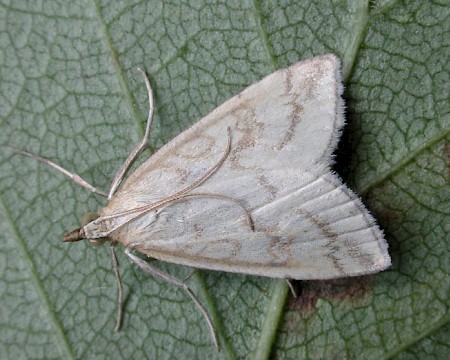63.033 BF1388
Udea lutealis
(Hübner, [1809])
Wingspan 23-26 mm.
This very common species throughout Britain is fairly easily recognised by the pale creamy forewings and darker cross-lines and outlined shapes.
The caterpillars live in spring on a wide variety of herbaceous plants, including bramble (Rubus).
Flying at night between July and August, it can be found in any suitable habitat.
Larva: (description Ian F. Smith)
Foodplant: Many plants, including; Succisa, Tussilago, Calystegia, Heracleum, Rumex, Rubus, Centaurea, Plantago, Fragaria, Cirsium and Artemisia.
Sept. - June. Under a white web on underside of leaf. Narrow leaves may be spun into a tube.
Length: Variable. Well fed early instar green specimens in January may be longer (e.g.15 mm) than late instar amber specimens in June (e.g.13mm)
Head: Yellowish white with a few brown marks (early instar). Pale yellowish brown with a few brown marks (late instar). Black postero-lateral mark. Stemmata blackish brown, but stemmatal area concolorous with head.
Prothoracic shield: Shiny, translucent, concolorous with lateral areas of body. May have brown lateral mark.
Thoracic legs: Concolorous with venter.
Body: Transparent yellowish green showing bright green viscera dorsally (early instar). Transparent light amber showing darker amber viscera dorsally (late instar). Contractile dorsal vessel shows as wide dark dorsal line. Wide whitish subdorsal line. Dark faecal pellets may be visible in posterior segments.
Spiracles: Concolorous. Internal horizontal trachea clearly visible as a thin spiracular line.
Pinacula: Concolorous, unobtrusive.
Setae: Golden, translucent (early and late instars).
Anal segment: The whitish subdorsal lines of the abdomen coalesce on the anal segment, with transparent spots revealing the darker viscera.
Prolegs: Concolorous with venter. Planta elongated, thin. Crochets reddish brown, in entire circle.
See also Cirsium key.

 UKMoths
UKMoths 






